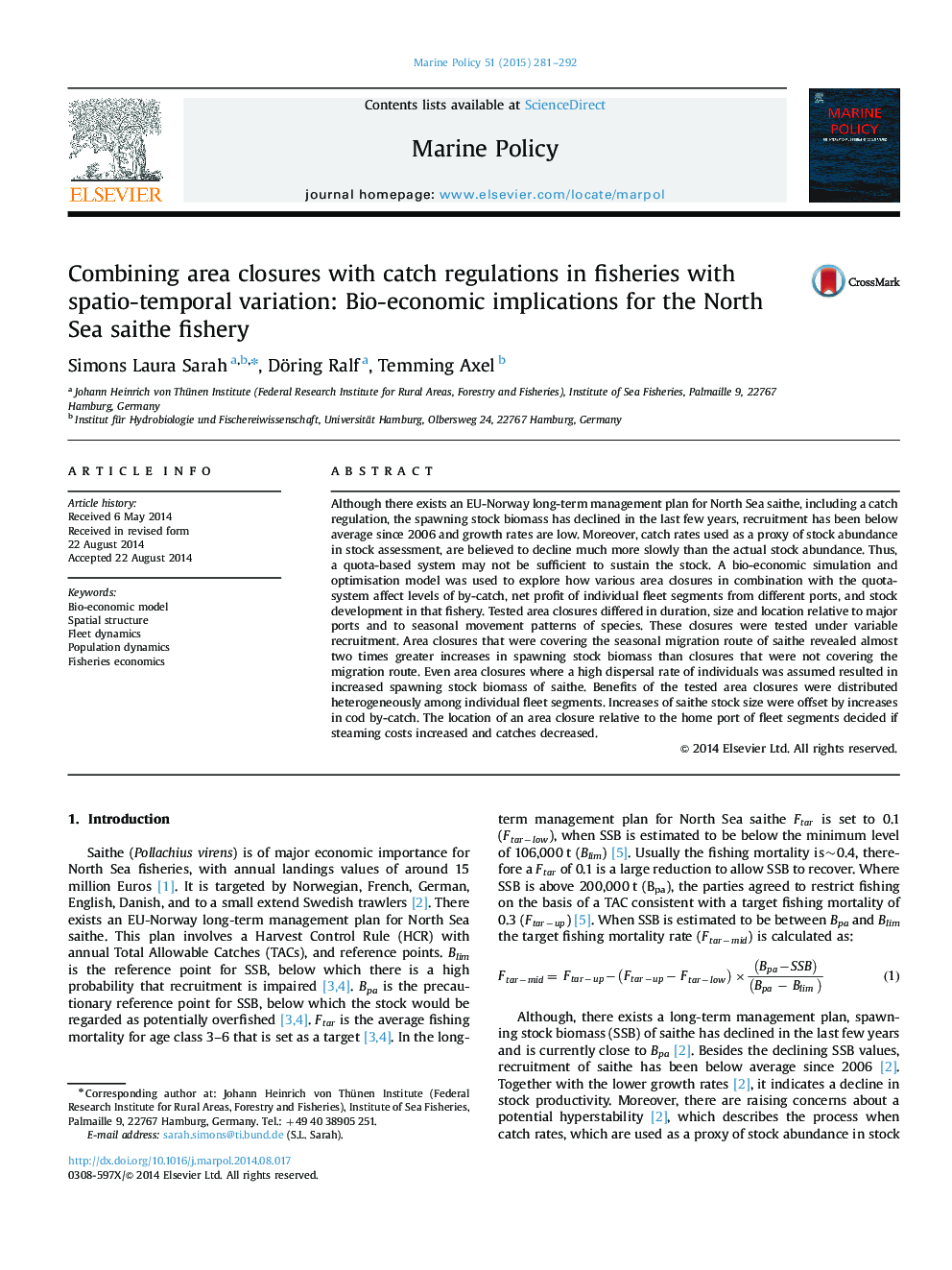| کد مقاله | کد نشریه | سال انتشار | مقاله انگلیسی | نسخه تمام متن |
|---|---|---|---|---|
| 7490869 | 1485528 | 2015 | 12 صفحه PDF | دانلود رایگان |
عنوان انگلیسی مقاله ISI
Combining area closures with catch regulations in fisheries with spatio-temporal variation: Bio-economic implications for the North Sea saithe fishery
ترجمه فارسی عنوان
ترکیب محدودیت های منطقه با مقررات گرفتن در ماهیگیری با تنوع فضایی و زمانی: پیامدهای بیرونی اقتصادی برای ماهیگیری دریای شمال
دانلود مقاله + سفارش ترجمه
دانلود مقاله ISI انگلیسی
رایگان برای ایرانیان
کلمات کلیدی
مدل اقتصادی بیولوژیکی، ساختار فضایی، دینامیک ناوگان، دینامیک جمعیت، اقتصاد شیلات،
ترجمه چکیده
اگر چه یک طرح مدیریت بلند مدت اتحادیه اروپا و نروژ برای دریای شمال دریای شمال، از جمله تنظیم مقررات، وجود دارد، زیست توده سهام تخم ریزی در چند سال گذشته کاهش یافته است، استخدام از سال 2006 کمتر از حد متوسط است و نرخ رشد پایین است. علاوه بر این، میزان جذب استفاده شده به عنوان یک پروکسی از فراوانی سهام در ارزیابی سهام، به نظر می رسد کاهش بسیار آهسته تر از فراوانی سهام واقعی است. بنابراین، یک سیستم مبتنی بر سهمیه ممکن است برای حفظ سهام نباشد. یک مدل شبیه سازی بیولوژیکی و بهینه سازی برای کشف اینکه چگونه بسته شدن منطقه های مختلف در ترکیب با سیستم سهمیه بر میزان جذب، سود خالص بخش های ناوگان مختلف از بنادر مختلف و توسعه سهام در آن ماهیگیری تاثیر می گذارد، مورد استفاده قرار گرفت. بسته شدن مناطق آزمایش شده در مدت زمان، اندازه و موقعیت نسبت به بنادر اصلی و الگوهای حرکت فصلی گونه ها متفاوت بود. این بسته ها تحت استخدام متغیر مورد آزمایش قرار گرفتند. بستن های منطقه ای که مسیر مهاجرت فصلی را پوشش دادند، افزایش تقریبا دو برابر افزایش بیوماس موجود در انبارها را نسبت به بسته ها که مسیر مهاجر را پوشش نمی داد، نشان می دهد. حتی بسته شدن مناطق که در آن نرخ پراکندگی بالا افراد تصور می شد، منجر به افزایش زیست توده زیستی بذر سیتی شد. مزایای بسته شدن محدوده مورد آزمایش در نواحی مختلف ناوگان ناحیه توزیع شد. افزایش میزان سیتی با افزایش میزان جذب ماهیانه، جبران شد. محل توقف یک منطقه نسبت به بندر اصلی بخش های ناوگان تصمیم گرفت اگر هزینه های بخار افزایش یابد و کاهش پیدا کند.
موضوعات مرتبط
مهندسی و علوم پایه
سایر رشته های مهندسی
مهندسی دریا (اقیانوس)
چکیده انگلیسی
Although there exists an EU-Norway long-term management plan for North Sea saithe, including a catch regulation, the spawning stock biomass has declined in the last few years, recruitment has been below average since 2006 and growth rates are low. Moreover, catch rates used as a proxy of stock abundance in stock assessment, are believed to decline much more slowly than the actual stock abundance. Thus, a quota-based system may not be sufficient to sustain the stock. A bio-economic simulation and optimisation model was used to explore how various area closures in combination with the quota-system affect levels of by-catch, net profit of individual fleet segments from different ports, and stock development in that fishery. Tested area closures differed in duration, size and location relative to major ports and to seasonal movement patterns of species. These closures were tested under variable recruitment. Area closures that were covering the seasonal migration route of saithe revealed almost two times greater increases in spawning stock biomass than closures that were not covering the migration route. Even area closures where a high dispersal rate of individuals was assumed resulted in increased spawning stock biomass of saithe. Benefits of the tested area closures were distributed heterogeneously among individual fleet segments. Increases of saithe stock size were offset by increases in cod by-catch. The location of an area closure relative to the home port of fleet segments decided if steaming costs increased and catches decreased.
ناشر
Database: Elsevier - ScienceDirect (ساینس دایرکت)
Journal: Marine Policy - Volume 51, January 2015, Pages 281-292
Journal: Marine Policy - Volume 51, January 2015, Pages 281-292
نویسندگان
Simons Laura Sarah, Döring Ralf, Temming Axel,
